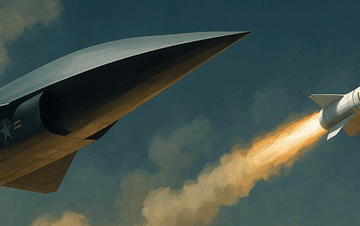The United States is by far the largest contributor to North Atlantic Treaty Organization (NATO) operations. According to NATO estimates published in June 2024, the United States will spend $967.7 billion on defense in 2024, roughly 10 times as much as Germany, the second-largest spending country, with $97.7 billion.
Total NATO military expenditures for 2024 are estimated at $1.474.4 trillion. As Russia grows increasingly assertive, many on both sides of the Atlantic are wondering how NATO member-states will step up and contribute to the continent’s defense.
To withstand a Russian attack, NATO must plan for between 35 and 50 extra brigades of 3,000–7,000 troops each—adding 105,000–350,000 soldiers. Germany must contribute 3–5 extra brigades or 20,000–30,000 combat troops.
Protection from air attacks is a major German and Eastern European vulnerability. Former German Defense Minister and current President of the European Commission Ursula van der Leyen recently emphasized the need for Germany, under its new defense plans, to quadruple its air defenses. That includes Patriot missile batteries and shorter-range systems to protect bases, ports, and railway transportation systems.
Should Russia attack NATO, hundreds of thousands of troops, together with tanks, equipment, and ammunitions, will have to make their way to the eastern front through Germany. Preparations for war with Russia indicate that Poland, the Baltics, and other Eastern NATO allies are primary targets, but so is Germany. During the Cold War, Germany had 36 Patriot missile air defense units. The count is down to nine—after donating three to Ukraine. Berlin just ordered four Patriot missile units at a cost of 1.35 billion euros.
The United States spends about 3.5 percent of its gross domestic product (GDP) on defense, but the Congressional Budget Office projects that will fall to 2.5 percent by 2034. NATO member-states recently issued a joint communique that said, “We reaffirm that, in many cases, expenditure beyond 2 percent of GDP will be needed in order to remedy existing shortfalls and meet the requirements across all domains arising from a more contested security order.”
The Baltic states are adamant about the need for increased defense spending. Tuuli Duneton, Estonia’s Undersecretary for Defense Policy, praised the 23 NATO member-states who now meet the 2 percent spending target. She suggested raising the spending goal to 2.5 to 3 percent.
Pointing to NATO’s “capability gaps,” Lithuanian Defense Minister Laurynas Kasčiūna stated, “We’ll start to talk at least about 2.5 percent as a floor,” pointing to NATO’s “capability gaps.” He added, “When we analyze what the countries need to develop soon, for a decade maybe, it’s not even 2.5 percent. It’s not even 3 percent. It should be more if you want more air defense systems, if you want more long-range strike capabilities.”
NATO plans focus on logistics, troop movement, and cyber defenses in preparation for conflict with Russia. After NATO’s plans for the biggest defense upgrade in three decades were agreed upon last year, now is the moment of truth: the minimum defense requirements to meet these plans were sent to national governments, highlighting significant shortfalls in air defenses, long-range missiles, troop numbers, ammunition, logistics, and secure digital communications.
Fixing these shortfalls requires billions of euros in investment. By autumn 2025, NATO aims to set binding targets for members to ensure Europe’s defense. Achieving these targets may be difficult due to budgetary constraints and differing views on NATO’s stance towards Russia.
NATO’s effort to navigate a moment of clear and present danger is made more difficult by the Herculean task of rearming. Deep industrial reconstitution and technological evolution are both needed and taking place across all value chains in all defense tech investments, including space, cyber, drones, and the role of artificial intelligence on the battlefield. Despite its current state of political uncertainty, change-adverse politicians and populations must be convinced of the need for refocusing on defense.
Europe must face a Kulturkampf in which Europeans overcome the three decades of cognitive denial about war in Europe. The biggest obstacle to the above efforts is likely to come from populations that are accustomed to generous welfare programs at the expense of defense preparations. Europe cannot tax its way out of its current problem. European taxes are already the highest in the world.
Compelling communication strategies are essential to justify the increased defense budgets. Officials need to emphasize the pan-European necessity for national and regional security. The twin brother of blood and treasure returned from a long hiatus. Making the argument to citizens becomes an even tougher sell if conscription across Europe is required to mobilize hundreds of thousands of troops to fight.
Asking ordinary citizens in Western or Southern Europe whether they are willing to die for Ukraine or Lithuania or even Poland will likely draw a negative response. Not all European populations seem willing, able, and ready to fight as nation-states united under the concept of pan-European patriotic defense. Those now leading the effort de guerre are found among Poles, Balts, and, in no small part, the newly energized Nordic countries.
In short, if Europe wishes to survive, it must adapt, deter, and defend itself now. Waiting will only add more blood and treasure to the bill that must be paid.
Christophe Bosquillon is a Senior Fellow at the National Institute for Deterrence Studies. He has over 30 years of international experience in general management, foreign direct investment, and private equity and fund management across various industries in Europe and the Pacific Basin. Views expressed in this article are the author’s own.
About the Author

Christophe Bosquillon
Christophe Bosquillon is a Senior Fellow at the National Institute for Deterrence Studies. He has over 30 years of international experience in general management, foreign direct investment, and private equity and fund management across various industries in Europe and the Pacific Basin.




